This is the 4th generation of attic antennas here at the AC0C QTH. And this one is by far the most complex I've attempted. The original design concept and build are explained below, and in the presentation PDF at the link below.  Download a complete presentation on the antenna project (5Mb) HERE Download a complete presentation on the antenna project (5Mb) HERE
Antenna Overview - As the Array was First Built... See REBUILD pages for the latest Features and individual antenna configurations include: - Microprocessor controlled antenna selection tied to rig’s band data.
- Automatic direction setting via DXLABS DXVIEW (thanks Dave). Fully integrated with CWSKIMMER sessions (thanks Dick).
- Loaded 160m and full size 80m dipole. On 160m, a hairpin match is automatically activated to offset the lower resistance feedpoint (due to the 80m loading coils)
- 40m – full size 2-element electrically reversible v-yagi ** NEW** 40m Now Phase Driven ** NEW **
- 30m – full sized 2-element v-yagi fixed east – optional electrical bidirectional control pending 40m performance verification
- 20m – full sized 3-element electrically reversible v-yagi
- 17/15/10 3-element horizontal yagi, electrically reversible
- 12m 3-element v-yagi fixed east. The DE shares the same element as the 80/160m dipole and is trapped for 12m.
- 6M – 3-element bi-directional figure-8 pattern pointing ENE-WSW
Design development was done in MMANA-GAL and again was key to the project's success. MMANA-GAL takes a lot of the work out of optimization - and the more complex the array, the more useful that tool becomes. This array replaces the prior antenna - a reversible 20/30/40m wire yagi with trapped elements (see Generation 3 - Trap Wire Beam). The traps provided very poor reliability in RTTY service - and their use prevented optimization at frequencies widely spaced enough to be efficient. In the new array, traps were avoided totally on the director/reflector elements. And only used on the center element which serves DE duty for the 12m beam. The 80m trap uses 1/4" copper tubing and 15KV vacuum caps, by comparison! I predict no more trap failures. Take a look at the photo of the traps and see if you agree. :) Antenna lovers - Click HERE to download a file with radiation patterns from the simulation for each band. TopologyThe overall topology of the array is shown in the drawing below. In total, there are 10 bands served by the array. Where possible, multi-element yagi structures were used. And in many cases, the electrically reversible switched inductor method was carried forward in this design. Size: Attic volume is 16' high, 20' in "beem length" and 40' wide. The apex of the house is about 45' above ground level. The rear of the house slopes down and away giving an improved "east beaming" height above ground level. I've not done a proper land survey to see the effect, but the performance in the east-north-east orientation is defainately better than the west facing direction. This could be ground effects - or unmoddled features of the house. 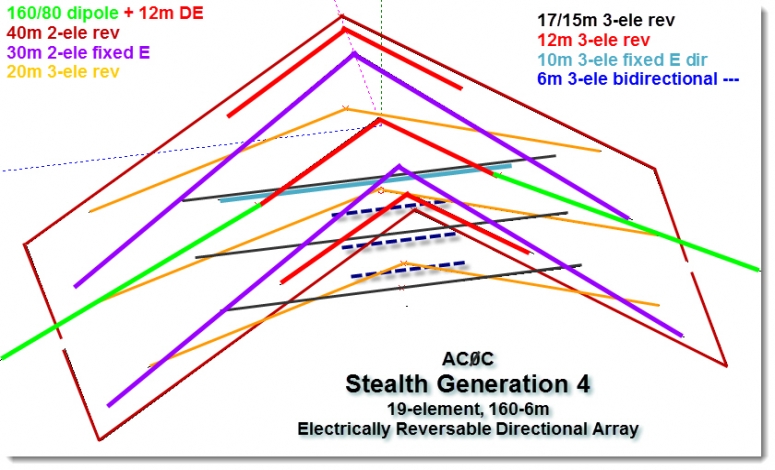
Design Focus
If you followed the descriptions of the prior generations, this antenna is really a logical extension. In this array there were two new objectives:
- Design - Use mono-band designs where possible - this simplifies the optimization for that band and allows simplified matching (hairpins, etc) which are band specific and avoid traps or other multi-band compromises
- Implementation - Because so many of the ham bands are harmonically related, provide some method to detune the unused elements so that they don't disrupt the antenna's pattern
80M Trap - 160M Loading Coil  Traps are used on the driven element in 2 places. Near the apex for 12m and then again for 80m. With the traps, the antenna is resonant at 24.900, 3.740 and 1.825 MHz. Given the troubles with the prior generation traps, I wanted to ensure that the new traps were indestructible. The new design is 1/4" copper tubing on a 5" form. The capacitor is a 15KV 100 pF 5% Russian surplus unit. Hi-Pot testing of the caps showed only a few uA of leakage at 15KV. I did not measure the traps Q but would guess its in the 300+ range based on similar work. The only compromises that were made were putting the metal components within the coil and the use of dissimilar metals in direct contact. As the coils would be not used in the outdoor weather environment,I felt these were negligible factors on the overall design. After having participated in several RTTY contests now, I can say the traps are performing very well indeed! 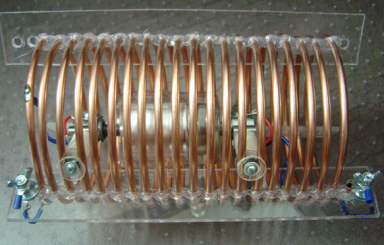
Antenna Mounted Isolation Modules 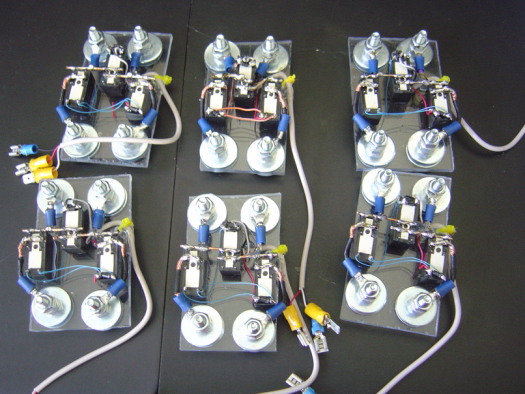
Detuning of the elements not used for a given antenna is accomplished by the isolation modules. The module allows the center of the dipole elements to be open or shorted - and for driven elements - connecting or disconnecting the coax from the element. A total of 42 separate relays are required to imp element the array's functions. Attic Mounted Relay Switching ModuleThe isolation module relays are driven from a master control board in the attic. Inputs to the module are:
- BCD data from the shack's Ameritron automatic antenna switch
- Selection of the driven elements from the shack's control head
- Selection of the open/short combination to provide minimum interference with the antenna pattern
- Buffers the direction line (east/west)
The switching module decodes these inputs and switches the relays to the correct positions. The power supply is fused on both the primary and secondary side. RF bypassed on both sides. All lines into and out of the module are bypassed by 200 mH inductors and 0.1 uF caps in an L network. No RFI effects have been observed to date. The terminal strips allow easy connection of the various lines running to the relay and power lines. A DB15 connects the lines from the control heads. IC content of the board is minimal - a BCD decoder and relay driver arrays. The heat sinks as shown here are inadequate and need to be replaced or supplemented. The LEDs adjacent to each connection help in diagnostics and confirm which lines are active . To facilitate diagnostics,a jack on the board connects to a remote push-button switch to allow local override and switching of the antenna direction and 15/17m lines. A DIP switch allows selection of open/short combinations. 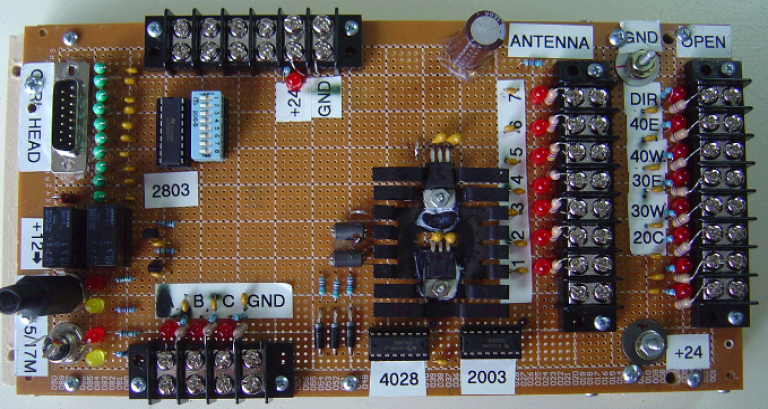
The switching module is mounted on a backing board which is secured to the studs in the attic. The backing board provides a DC power supply for the module. And serves as a mounting plate for the Ameritron 8-position antenna switch head. 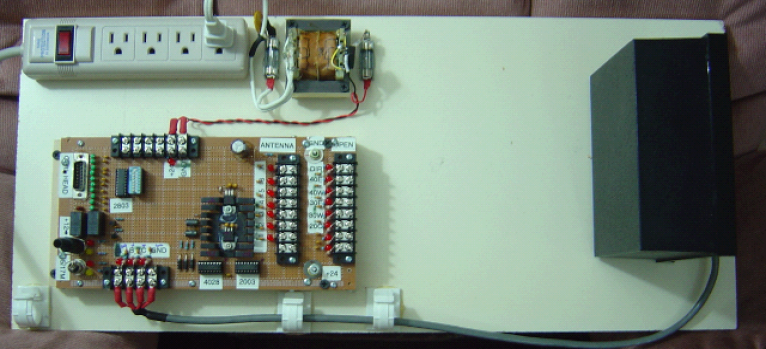
Shack Mounted Control Module The heart of the system is the control module. It's tied into the rest of the shack hardware as summarized by the topology in the drawing below. 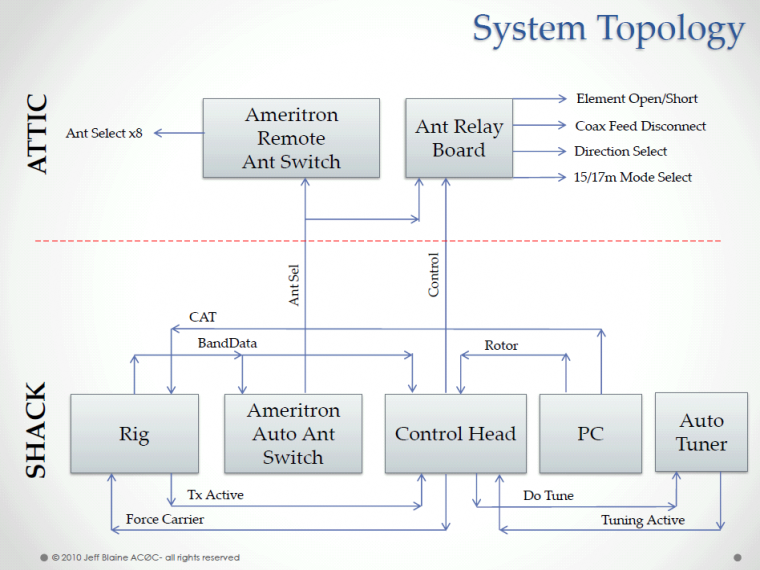
The control head is shown below. Functions are labeled. Notice that auto-tuner control as well as pulse/carrier buttons are present to make amp tune-up easy. 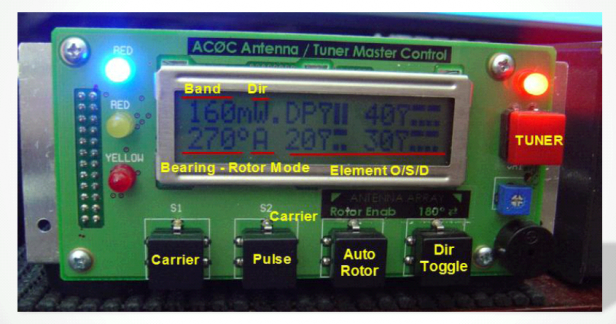

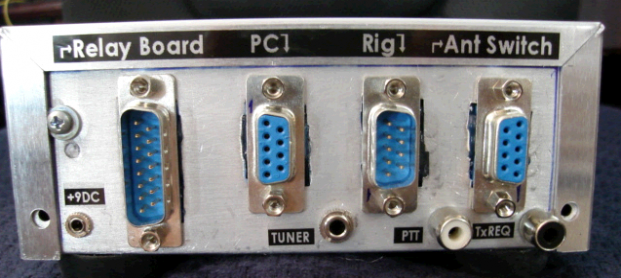
ATTIC VIEWS 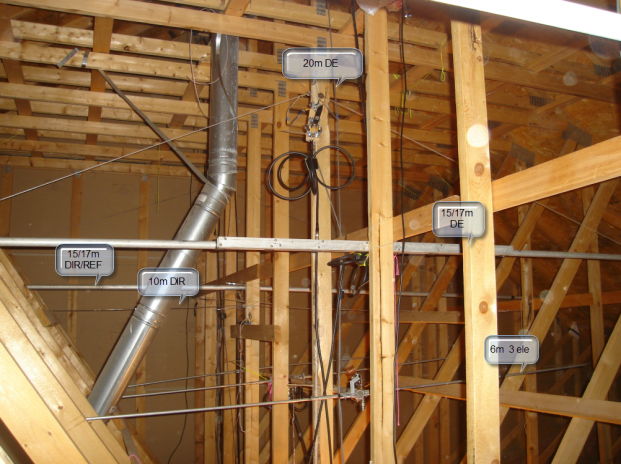 

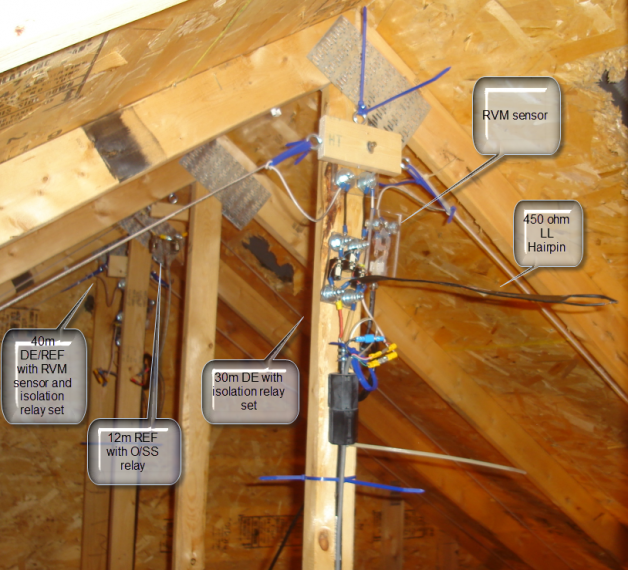
|